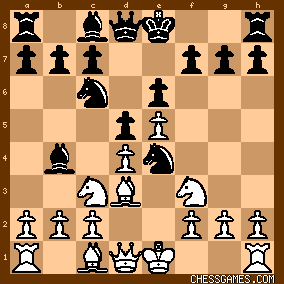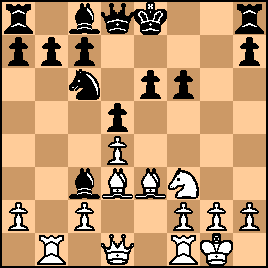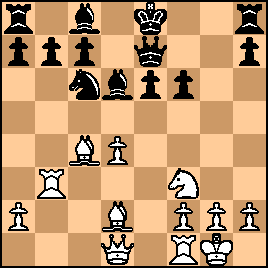| Nov-01-10 | | laikn1: Hehe! No comment for this game? Strange! |
|
| Mar-10-12 | | zev22407: A fine attacking game by Schelechter |
|
Mar-11-12
 | | DrNyet: Interesting. It hadn't occurred to me before, but if a system is desired to make wins more valuable than the normal scoring system, leaving wins worth 1 point and making draws worth only 1/3 (or some other fraction less than 1/2) seems easier to follow -- somehow more intuitive -- than making wins worth 3 points as we've seen lately. |
|
Mar-11-12
 | | wwall: There were 20 players in this event.
Maroczy only lost only to Schlechter and Gunsberg. Draws were 1/4 point.Perhaps Maroczy shouldn't have castled kingside as White gets a good attack after 17.Nh4-Nf3-Ne5-Qh5. 17.Bh6 would also have been good after 17...Rf7 18.Ne5 fxe5 19.Rg3+ After 20.Qh5, White threatens 21.Rg3+.
23.Bxc5! was good, which deflects Black's queen from going to g7 later. 25.Rxg6+! looks strong, since 25...hxg6 allows 26.Qxg6+ Kh8 27.Re3, threatening 28.Rh3 mate. After 28.Rxe6, now White is a pawn up in a good endgame. Instead of 30.Rd3, perhaps stronger is 30.Qe6
32...f3 looks weak. Perhaps 32...Kg7 or 32...h6.
33...Rxg2+ looks hopeless. Perhaps 22...Re7 23.Qxf3 Kg8. After 35.Qxf3, Black can resign. |
|
Nov-24-22
 | | KEG: A fine game by Schlechter who grabbed the initiative with a fine pawn sacrifice on move 7, followed up aggressively, and then obtained a winning attack after Maroczy's misplays on moves 14 and 15. From that point on, though not always selecting the fastest lines to victory, never gave Maroczy any real chances to recover. Prior to this 12th round game, Maroczy had been undefeated and appeared to be coasting to first place. After this loss,however, his margin over second-place Pillsbury narrowed, and Maroczy had to struggle through the concluding of his final game to take the title by a mere 1/4th of a point. Maroczy and Schlechter were evenly matched. All ten of their earlier games were drawn, and over the course of their careers, their rivalry ended at two victories each with 29 draws, This game is a reminder--if such were truly needed--that Schlechter was one of the giants of the early 20th century until his untimely and tragic death from the Spanish epidemic in 1918, Schlechter held his own with all the other top players other than Emanuel Lasker (who despite their drawn match in 1980 ended with five wins against two loses to Schlechter lifetime [plus 12 draws]); Pillsbury (against whom Schlechter seemed unable to compete and won eight games against Schlechter's two--with nine draws); Akiba Rubinstein(who had a record of 6 wins against two losses against two loses against Schlechter and was the only player to prevail in a set match against Schlechter) and--most surprisingly--Frank Marshall whose record of 8-5-20 against Schlechter does not in my opinion reflect the actual relative strength of these two players. Meanwhile, Schlecter had substantial plus scores against Tchigorin; Janowsk, Gunsberg,and Reti, and also plus lifetime scores against Alekhine, Nimzovitsch, Spielman and Vidmar, and only slightly negative scores against Tarrasch, Teichmann, Bernstein, and Blackburne. Schlether's overall score against the four world champions he played (Lasker, Capablanca, Alekhine, and Steinitz) was seven wins,seven draws, and 15 draws. What a loss for chess that Schlechter was not around in the 1920's! 1. e4 e6
Maroczy knew the French Defense well, but here Schlechter had a surprise for him. 2. Nc3
A harmless transposition instead of just playing the usual 2. d4. 2... d5
3. d4 Nf6
So we have a normal Classical variation in the French Defense. 4. Bd3

click for larger viewA Blackburn favorite at the time, but not otherwise frequently played before this game. The move got a serious work-out in the 1907 Lasker-Marshall match in which Lasker played 4. Bd3 three times as White, winning all three games. Objectively, 4. Bd3 with best play yields no edge to White. But here, Maroczy had his own surprise. Instead of the usual equalizing 4...c5, Maroczy played: 4... Nc6

click for larger viewThis blocks the Black c-pawn and looks awkward. I know of only two instances in which this move was played before the instant game, and only a few later examples. Nonetheless, I agree with the Tournament Book that Maroczy almost certainly knew what he was doing. 5. Nf3
5. e5 is another way to combat Maroczy's unusual variation, but the solid text is also good and in accordance with Schlechter's slow but steady positional and attacking style. 5... Bb4
Marcozy's move is probably as good as the alternative: 5...Nb4. 6. e5
As always, Schlechter was in no rush. 6. Bg5 and 6. exd5 (and maybe 6...0-0) are the critical lines in assessing the merits of the variation played here by Maroczy. 6... Ne4!

click for larger viewThe move Maroczy must have been planning. It appears to equalize. But Maroczy probably had not reckoned on the pawn sacrifice that Schlechter now sprang on him here that made the game the exciting struggle it soon became. |
|
Nov-24-22
 | | KEG: Post II
7. 0-0?!
7. Bd2 was the solid choice, but Schlechter decided rapid development and attacking chances were worth a pawn. The text defined much of what followed. Maroczy was a dangerous opponent against whom to sacrifice a pawn, but Schlechter knew how to exploit the sorts of chances he got here. 7... NxN
Accepting the proffered pawn. In fact, anything else would be bad for Black. 8. bxN Bxc3
Once again, anything else would put Black in serious difficulties. Besides, a pawn is a pawn...right? 9. Rb1

click for larger viewTime to take stock. White plainly has compensation for the pawn. The immediate question, of course, was whether Maroczy could afford to grab the Whited-pawn. The Tournament Book contended that 9...Nxd4 was best and equalizes. In fact, chances would be about equal after 9...Nxd4 10. NxN BxN 12. Bb5+ c6 [obviously forced] 12. QxB cxB and now 13. Rxb5 [and not the Tournament Book's suggested 13. Qg4?! Kf8 14. Rxb5 which leaves Black better] leaves the game very much in the balance, with Black a pawn ahead but White much better developed. The question presented was whether Black could do better than this. The best chance of accomplishing this would have been with the prophylactic 9...h6 which probably leaves Black with slightly better chances. But Maroczy thought there was more in the offing for Black and courted trouble with: 9... f5?!
10. exf6 e.p. gxf6

click for larger viewMaroczy's idea left him in a difficult position, since Black's busted King-side was more than adequate compensation for White's pawn minus. Schlechter here seemingly had a number of ways to try to exploit his initiative. The simplest was probably to regain the pawn with 11. Bxh7 RxB 12. Qd3 leaving White much better placed. Other good aggressive options for White were 11. Rb3 (probably best); 11. Bb5 and maybe 11. Be2 followed by Rb3 and Nh4. But as always in these sorts of situations, Schlechter was in no hurry: 11. Be3
A nice example of Schlechter's style: slowly building an attack while giving his opponent little to work with: 
click for larger view11... Qe7!
Nicely combining defense with offensive.
12. Rb3!
Schlechter rightly concluded that having his Rook poised to operate on his third rank would put the most pressure on Black. 12... Bb4
Probably superior to 12...Ba5.
How now should Schlechter proceed to justify his pawn sacrifice: 
click for larger view13. Bd2
The computers give 13. Nh4 with a small edge to White. Schlechter, however, continued methodically, apparently confident that he could retain compensation for the pawn by denying Maroczy counterplay. 13... Bd6?
A surprisingly lame effort from the usually reliable Maroczy. 13...Bd7 would leave approximately equal chances for both sides. By contrast, the text gave Schlechter an opportunity he was now slow to exploit: 14. c4!
"!"--(Tournament Book)

click for larger viewSuddenly, and despite his pawn minus, all the chances lay with White. To hold the position, Maroczy had to play precisely. But Maroczy's next two moves were sloppy and gave Schlechter a winning advantage that he never relinquished. |
|
Nov-24-22
 | | KEG: Post III
14... dxc4?
This and the following moves are rare examples of sloppiness by the usually careful Maroczy. He needed to defend and get his Queen off e7 (both to make room for his d6 Bishop and also to defend and avoid pins on the e-file. He thus should have played 14...Qf7 or 14...Qg7. The text, by contrast, only fueled Schlechter's attack. 15. Bxc4

click for larger view15... Nd8?
Just awful and leaving Maroczy in a hopeless position. Much better were 15...0-0 or 15...Qf7 or 15...Bd7. 16. Re1
Schlechter's relentless technique from this point is a delight to play over. 16. Nh4 immediately was also very strong.
16... 0-0
<wwall> rightly condemns this move. While not sufficient to cure all of Black's ills, 16...Rg8 or 16...Qf7 would have offered tougher resistance. After the text, Schlechter's patient attack only gained momentum with the Black King sitting nearly undefended on g8: 
click for larger view17. Nh4
17. Bh6, as pointed out on this site by [wwall] was another powerful method of proceeding for White. 17... f5
"Black has no choice. 17. Nf5 must be prevented." (Tournament Book) The text drastically exposes the Black King-side. But like the Tournament Book, I see nothing better. White's attack now practically plays itself:

click for larger view18. Nf3
A typically patient but lethal Schlechter attacking scheme with his Knight now eyeing e5. Perhaps even stronger was 18. Rh3 immediately but, as always, Schlechter was in no hurry. 18... c6?
Uncharacteristic panic by Maroczy. In his current wretched position, he might as well have tried something like 18...b5?! or 18...f4. But neither of these suggestions were likely to save the day against Schlechter. 19. Ne5

click for larger viewWith the third rank cleared for Schlechter's Rook to come to h3 or g3 and with his Queen and dark-square Bishop set to join the fray, it is easy to understand why Maroczy faltered badly here--not that it mattered much to the eventual outcome. 19... Nf7
Further strangling his own forces, but I have no great ideas for Black here. 20. Qh5
Perhaps even faster would have been 20. Rg3+ Kh8 21. Qh5 BxN 22. dxB Rg8 23. RxR+ KxR 24. Re3 [bringing his remaining Rook to the assault via the third rank]f4 [there is nothing batter] 25. Rh3 Ng5 26. Rh4 Bd7 27. Bxf4 etc. 20... BxN?
Schlecther's almost plodding attack apparently frustrated Maroczy into this unfortunate (for him) exchange. But even the "better" 20...f4 had no real prospect of saving the day. As <wwall> points out, White threatened the crushing 21. Rg3+ 21. dxB
A more interesting winning idea is 21. Rh3 Nh8 22. RxB Rf7 23. Rxf5 RxR 24. QxR Bd7 25. Qb1 threatening...well just about everything. But Schlechter's move was entirely efficient. White was still down a pawn, but Black by now was sunk. 21... Nh8
Forced, but hopeless.

click for larger view |
|
Nov-24-22
 | | KEG: Post IV
22. Bb4
"?"--(Tournament Book)
As the Tournament Book noted, 22. Rg3+ Ng6 23. Bh6 followed by a [very temporary] exchange sacrifice on g6 "wins easily" [e.g., 23...Bd7 24. RxN+ hxN 25. Qxg6+ Kh8 26. BxR RxB 27. Re3] 22. Bh6 was also a killer.
But the Tournament Book's "?" is unjustified since less exciting move also wins. 22... c5
Pretty much forced.

click for larger view23. Bxc5
"!"--<wwall>
The text, as <wwall> notes, deflects the Black Queen from getting to g7. Schlecter could have accomplished much the same thing with 24. Rg3+ Ng6 25. Bxc5 23... QxB
24. Rg3+ Ng6

click for larger view25. RxN+ Kh8
As per <wwall>, if 25...hxR 26. Qxg6+ Kh8 27. Re3 threatening 28. Rh3 mate and forcing Black to give up his Queen. 26. Qh6
26. Qh4 was probably faster, but Schlechter's move does the job quite adequately. 26... Rf7
26...Qe7 might have offered stronger resistance--for a while at least. But Black is lost in either case. After 26...Rf7, the position was:

click for larger view27. Bxe6
27. Rd1 or 27. Rf6 would have been faster. But Schlechter's move also clearly wins (and with the move-30 time control approaching, may have been the best practical choice in over-the-board play). 27... BxB
28. RxB
To cite the superb analysis of <wwall> on this game yet again, White was now "a pawn up in a good endgame: 
click for larger view28... Rg8
The Tournament Book could find nothing better for Black, and neither can I. 29. Rd6 f4
A final desperate try by Maroczy to create complications: 
click for larger view30. Rd3
30. Qe6 as suggested by <wwall> is the killer, but this was the last move for Schlechter before the move 30 time-control, so I am loath to fault Schlechter's selection of what was also a winning move. 30... Qa5
31. Rdd1 Rg6
31...Qc3 was marginally better.
32. Qh3

click for larger view |
|
Nov-24-22
 | | KEG: Post V
32... f3!?
A wild coffee-house idea which <wwall> not unreasonable says "looks weak." His recommendation of 32...Kg7 was almost certainly theoretically superior, but after 33. Re4 the end for Black would have been near. 33. e6
Game over:

click for larger view33... Rxg2+?
Appropriately characterized as "hopeless" by <wwall>, But his suggested 33...Re7, though not leading to a quick mate, would also lose quickly after 34, Qxf3 Kg8 35. Qb3 After the text, Schlechter finished off the game briskly. 34. Kh1 Re7
35. Qxf3

click for larger view"Black can resign." (<wwall>) Agreed!
35... Rg8
36. Qf6+ Reg7
37. e7

click for larger view1-0
A cute finish to a well-played game by Schlechter. |
|
|
|
|





































